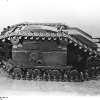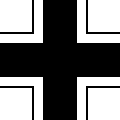Goliath tracked mine
|
|
This article has multiple issues. Please help improve it or discuss these issues on the talk page. (Learn how and when to remove these messages)
|
| Goliath Sd.kfz 302 | |
|---|---|

A SdKfz. 302, displayed at the Deutsches Panzermuseum, Munster (2005)
|
|
| Type | Demolition vehicle |
| Place of origin | Nazi Germany |
| Service history | |
| In service | 1942–1945 |
| Used by | Nazi Germany Romania |
| Wars | World War II |
| Production history | |
| Designed | 1942 |
| Manufacturer | Borgward and Zündapp |
| Unit cost | 3,000 ℛℳ (1942) (€12,577 in 2021) |
| Produced | 1942–1944 |
| No. built | 7,564 |
| Specifications | |
| Mass | 370 kg (820 lb) |
| Length | 1.5 m (4.9 ft) |
| Width | 0.85 m (2.8 ft) |
| Height | 0.56 m (1.8 ft) |
| Crew | One remote operator |
|
|
|
| Armor | 5 mm (0.20 in) |
|
Main
armament |
60 kg (130 lb) explosive charge |
| Engine | Two Electric Motors 2 x 2.5 hp (1.9 kW) |
| Ground clearance | 11.4 cm (4.5 in) |
|
Operational
range |
1.5 km (0.93 mi) on-road; 0.75 km (0.47 mi) off-road. |
|
Maximum speed |
6 km/h (3.7 mph) |
| References | |
The Goliath tracked mine (German: Leichter Ladungsträger Goliath, “Goliath Light Charge Carrier”) was a series of two unmanned ground vehicles used by the German Army as disposable demolition vehicles during World War II. These were the electrically powered Sd.Kfz. 302 and the petrol-engine powered Sd.Kfz. 303a and 303b. They were known as “beetle tanks” by the Allies.[1]
They carried 60 or 100 kg (130 or 220 lb) of high explosives, depending on the model, and were intended to be used for multiple purposes, such as destroying tanks, disrupting dense infantry formations, and the demolition of buildings or bridges.[2] Goliaths were single-use vehicles that were destroyed by the detonation of their warhead.
Development
[edit]
During and after World War I, a number of inventors devised small, remote-controlled, tracked vehicles intended to carry an explosive charge. During the war, the French developed two vehicles. The Crocodile Schneider Torpille Terrestre[3] (transl. ’Land Torpedo Crocodile Schneider’) carried a 40 kg (88 lb) explosive charge and saw limited combat use in June 1916. However, it performed poorly and was eclipsed by the first tanks, then being introduced.[4] The Aubriot-Gabet Torpille Électrique (transl. ’Aubriot-Gabet Electric Torpedo’) was driven by a single electric motor powered by a trailing cable. This vehicle may have been steered by clutch control on its tracks, although early versions may have lacked steering.[4] This may not have mattered as its task was simply to cross no man’s land to attack the long trenches of the enemy.[5] The Wickersham Land Torpedo was patented by American inventor Elmer Wickersham in 1918[6] and in the 1930s, a similar vehicle was developed by the French vehicle designer Adolphe Kégresse.
In late 1940, Kégresse’s prototype was recovered by the Germans near the Seine; the Wehrmacht’s ordnance office directed the Carl F.W. Borgward automotive company of Bremen, Germany to develop a similar vehicle for the purpose of carrying a minimum of 50 kg (110 lb) of explosives.[2] The result was the SdKfz. 302 (Sonderkraftfahrzeug, transl. ’special-purpose vehicle’), called the Leichter Ladungsträger (transl. ’light charge carrier’), or Goliath, which carried 60 kg (130 lb) of explosives. The vehicle was steered remotely via a joystick control box.[2] The control box was connected to the Goliath by a 650-metre (2,130 ft), triple-strand cable. The cable was stored on a cable drum in the rear compartment of the Goliath. The cable was used for steering the vehicle left/right, forwards and reverse (reverse on the electric driven 302 version only) and to ignite the explosive charge. Each Goliath was disposable, being intended to be blown up with its target. Early model Goliaths used two electric motors but, as these were costly to make (3,000 Reichsmarks) and difficult to maintain and recharge in a combat environment, later models (known as the SdKfz. 303) used a cheaper two-stroke petrol engine.[7]
Service
[edit]
| Goliath Sd.kfz 303 | |
|---|---|

An SdKfz. 303, the petrol powered version of the Goliath
|
|
| Type | Demolition vehicle |
| Place of origin | Germany |
| Service history | |
| In service | 1943–1945 |
| Used by | Nazi Germany |
| Production history | |
| Designed | 1942 |
| Manufacturer | Zündapp and Zachertz |
| Produced | 1943–1945 |
| No. built | 4,929, both the model a and model b |
| Specifications | |
| Mass | 430 kg (950 lb) |
| Length | 1.69 m (5.5 ft) |
| Width | 0.91 m (3.0 ft) |
| Height | 0.62 m (2.0 ft) |
| Crew | One controller with remote. |
|
|
|
| Armor | 10 mm (0.39 in) |
|
Main
armament |
100 kg (220 lb) explosive charge |
| Engine | Zündapp SZ7 / 2-cylinder 12.5 hp (9.3 kW) |
|
Operational
range |
12 km (7.5 mi) on-road; 7 km (4.3 mi) off-road. |
Goliaths were used on all fronts where the Wehrmacht fought, beginning in early 1942. They were used principally by specialized Panzer and combat engineer units. Goliaths were used in Italy at Anzio in April 1944, and against the Polish resistance during the Warsaw Uprising in 1944.[2] A few Goliaths were also seen on the beaches of Normandy during D-Day, though most were rendered inoperative after artillery blasts severed their command cables. Allied troops encountered a small number of Goliaths in the Maritime Alps following the landings in southern France in August 1944, with at least one being used successfully against a vehicle of the 509th Parachute Infantry Battalion.[citation needed]
Although a total of 7,564 Goliaths were produced, the single-use weapon was not considered a success due to high unit cost, low speed (just above 6 kilometres per hour (3.7 mph)), poor ground clearance (just 11.4 cm (4.5 in)), the vulnerable control cable, and thin armour which could not protect the vehicle from small-arms fire. The Goliath was also too big and heavy to be easily man-portable.[8] They mostly failed to reach their targets, although the effect was considerable when they did.[8]
Large numbers of Goliaths were captured by the Allies. Although they were examined with interest by Allied intelligence, they were seen as having little military value. Some were used by the United States Army Air Force as aircraft tugs, although they quickly broke down as the disposable vehicles were not designed for sustained use.[8]
Romanian version
[edit]
In the years leading up to the Second World War, Romania designed and built its own model of remote-controlled tracked mine, commonly known as “Romanian Goliath”, but officially designated “Torpila terestră dirijată Eremia” (“Eremia guided land torpedo”).[9] It was markedly different from its later German counterpart. The few surviving photos show that the vehicle, unlike the German Goliath, had no armour at all, and it is not known if that was ever changed. The Romanian-designed chassis allowed it to cross trenches and craters much better than its German counterpart. Little more is known about the vehicle, other than that it never went beyond the prototype stage and that it weighed about two tonnes.[10]
Surviving examples
[edit]

Surviving Goliaths are preserved at:
- The Museum of World War II, Massachusetts, USA
- The Museum Stammheim, Germany
- the Deutsches Panzermuseum, Germany
- the Bundeswehr Military History Museum, Dresden, Germany
- The Technik Museum Sinsheim, Germany
- The Tøjhus Museum, Copenhagen, Denmark
- Heeresgeschichtliches Museum, Vienna, Austria
- the Musée du Débarquement Utah Beach, Normandy, France
- Musée des Blindés, Saumur, France
- Musee No. 4 Commando, Ouistreham, Normandy, France
- the Canadian War Museum, Ottawa, Ontario, Canada
- Fort Garry Horse Museum, Winnipeg, Manitoba, Canada
- United States Army Ordnance Museum
- Karl Smith collection, USA
- the Imperial War Museum, Duxford, UK
- The Tank Museum, Bovington Camp, UK
- The REME Museum, UK
- Dutch Cavalry Museum, Netherlands
- War Museum Overloon, Netherlands
- Het Nederlands kustverdedigingsmuseum: Fort aan den Hoek van Holland
- Het Memory Oorlogs- en Vredesmuseum Nijverdal, Netherlands
- Royal Museum of the Armed Forces and Military History, Belgium
- December 44 Museum, La Gleize, Belgium
- the Kubinka Tank Museum, Russia
- Arsenał in Wrocław, Poland
- Polish Army Museum, Poland
- Warsaw Uprising Museum, Poland
- Muzeum dopravy (transportation museum), Bratislava, Slovakia.
- Swedish Army Museum, Stockholm, Sweden
- Friends’ Association of the Scientific Collection of Defence Engineering Specimens Koblenz (VFF WTS), Koblenz, Germany[11]
- The Flying Heritage & Combat Armor Museum, Everett, Washington, USA
- Australian Armour and Artillery Museum, Smithfield, Queensland, Australia
See also
[edit]
- Borgward IV
- Mobile Land Mine, equivalent British World War 2 vehicle; fifty built.
- Springer (tank)
- Teletank, a series of Soviet remote controlled tanks
- Unmanned ground vehicle
References
[edit]
- Citations
- ^ Goliath Demolition Tank on YouTube
- ^ a b c d
Lauterborn, David (2011-05-05). “Goliath Tracked Mine: The Beetle That Started the ROV Craze”. HistoryNet. Retrieved 2025-06-24.
- ^ “Land torpedo Crocodile Schneider (France)”. weaponews.com.
- ^ a b Everett and Toscano (2015) p.412
- ^ Everett, Bart (February 19, 2017). “A Brief Early History of Unmanned Systems”. Mechanix Illisttated.
- ^
- ^ Army manual D 654/10, Leichter Ladungsträger, Gerätebeschreibung und Bedienungsanweisung. OKH. 1 April 1943.
- ^ a b c Everett and Toscano (2015) p.489
- ^ https://www.ziuaconstanta.ro/diverse/sapte-zile/generalul-eremia-inventatorul-torpilei-terestre-dirijate-erou-uitat-de-istorie-46974.html
- ^ ““Goliath” — Дистанционно управляемая машина”. October 5, 2018. Archived from the original on May 28, 2009.
- ^ “Friends’ Association of the Scientific Collection of Defence Engineering Specimens Koblenz | Home”.
- Bibliography
- Chamberlain, Peter, and Hilary Doyle (1999). Encyclopedia of German Tanks of World War Two, 2nd ed. London: Arms & Armour. ISBN 1-85409-214-6.
- H. R. Everett; Michael Toscano (6 November 2015). Unmanned Systems of World Wars I and II. MIT Press. ISBN 978-0-262-02922-3.
- Gassend Jean-Loup (2014). Autopsy of a Battle, the Allied Liberation of the French Riviera, August September 1944. Atglen PA: Schiffer Publications.
- Jaugitz, Markus (2001). Funklenkpanzer: A History of German Army Remote-and Radio-Controlled Armor Units, trans. David Johnston. Winnipeg, Manitoba: J.J. Fedorowicz Publishing, Inc. ISBN 0-921991-58-4.
- Jentz, Thomas L. Panzer Tracts, No. 14: Gepanzerte Pionier-Fahrzeuge (Armored Combat Engineer Vehicles, Goliath to Raeumer). S. Darlington, Maryland: Darlington Productions. ISBN 1-892848-00-7
- Morison, Samuel Eliot (1957). History of United States Naval Operations in World War II vol. 11. Boston, Mass.: Atlantic Monthly Press.
External links
[edit]
 Media related to Borgward “Goliath” at Wikimedia Commons
Media related to Borgward “Goliath” at Wikimedia Commons- Dutch Cavalry Museum has a Goliath-tank in its collection.
- Goliath in Kubinka tank museum
- Leichte Ladungsträger Goliath Sd.Kfz.302 (E-Motor)
- Leichte Ladungsträger Goliath Sd.Kfz.303a / Sd.Kfz.303b (V-Motor)



 RSS
RSS Contact Us
Contact Us